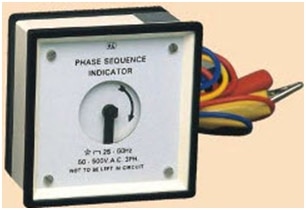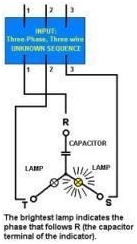
The correct phase sequence is required for the proper operation of any three phase system. It ensures that the load works as desired, when incorrect, the equipment such as the motor may malfunction, rotate in the reverse direction. The phase reversal may damage the motor or the equipment the motor is driving.
It is always important to ensure that the incoming 3-phase conductors have the correct phase sequence before connecting new equipment or before reconnecting motors after maintenance. This might not be obvious by visual inspection, hence the need for a reliable tool. The two commonly used methods are the rotating phase-sequence meter or the static phase-sequence indicator.
Test tools are used to confirm that the connection to motors and other three phase equipment is done right before commissioning. In addition, the phase-sequence indicators are used in confirming the wiring in switchboards with a three phase supply.
Phase sequence meter/indicator
The phase-sequence meter is the most straightforward and commonly used tool for determining the phase sequence. The meter may be digital using semiconductor devices, or rotational (analog) type.

A 3-phase tester | image: edgefx.in
Rotational phase sequence meter
These are small asynchronous motors consisting of an aluminum disk which serves as the rotor. The tester has three windings which are usually connected to the circuit under test. The principle of operation is similar to that of an induction motor.
The meter has coils whose one end of each is connected in a star configuration. The other three ends of the coils are attached to the motor power connections or the circuit under test. The meter contains an aluminum disk which rotates when the current through the coils creates a magnetic field.
The current through the three windings creates a magnetic field that depends on the phase sequence of the incoming power conductors, this causes the disk to rotate in the direction that depends on phase sequence. The meter terminals are marked with a certain phase sequence order. Once the disk rotates, the direction of the arrow on the disk shows the phase sequence, based on the marks.
The tool rotates clockwise when the phase sequence is correct (RYB) and anticlockwise when the phases are reversed.
Some general-purpose indicators may determine the phase sequence, power factor and phase shift between the current and voltage.
Static Type Phase-Sequence Indicators
The static indicator is a simple configuration that uses two lamps and an inductor or capacitor. One lamp is connected to one phase such as R and the other to another phase such as Y, while the inductor or capacitor on the remaining third phase. A resistor may be used in series with the lamp to control the amount of current and voltage.

Static phase sequence indicator | image: eiprocus.com
If using the inductor, lamp B will be more brighter than A if the phase sequence is correct, while Lamp A becomes brighter when the phases are reversed.
However, using the capacitor tester, Lamp A will light on while lamp B will be off. If the sequence is incorrect, lamp B lights up while lamp A remains off.

Typical phase sequence testing arrangement, using the static indicator | image: edgefx.in
Conclusion
In three-phase equipment such as motors and measuring instruments, the correct phase sequence determines whether the motor will rotate in the right direction, or if the instrument works as expected. However, the phase sequence may not be obvious and it is important to have a means of verifying that the sequence is correct, otherwise the system may not function properly or as expected.
The two commonly used methods are the phase sequence meter or the static indicator. The meter is simple and easy to use, but is more costly. On the other hand, the static indicator is cheap and easy to make and use.